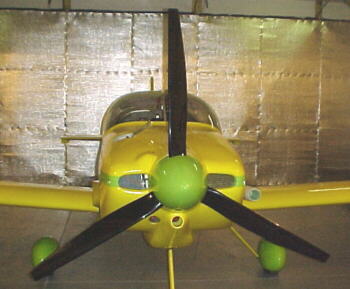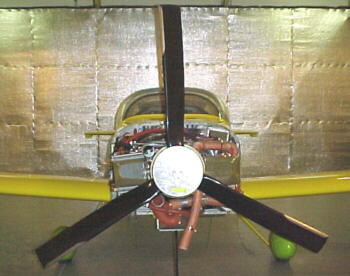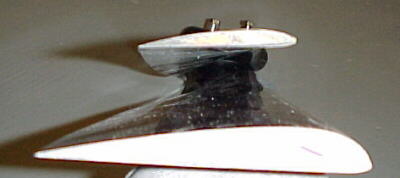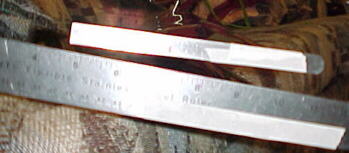

Standard Magnum blades left, Magnum paddle blades right


For the first 20 hours of flight testing, the aircraft was fitted with an in-flight adjustable, IVO 76 inch, 3 blade Magnum with 45-105 inch pitch range. These propellers use a DC motor driving a screw jack and trunion to move torsion rods buried into the composite blades to twist the blades, leaving the hub portion of the blades motionless. The propeller has performed well but the aircraft is underpropped at higher power settings. On Feb. 17/04 a new set of paddle blades with 30-90 inch pitch range was fitted for evaluation.


Standard Magnum blades left, Magnum paddle blades right

Note extra area of paddle blades, standard blade on top


Airfoil thickness difference at tips, angle difference at tips was measured at 5 degrees
The weight difference between the standard and paddle blades is a half pound per blade. While the hub was partially disassembled, I ran an ammeter test to see blade angle vs. current draw relationship. 2 amps was the draw in the neutral pitch range and at 11 amps, the trunion was starting to touch the nylon washer pitch stops. This was with 2 blades installed to observe movement. I'd estimate about 14 amps would be required with all 3 blades installed to reach the pitch stops.
02/22/04
Performance with the paddle blades was disappointing. This prop does not absorb as much torque as the higher pitched standard Magnum. Static rpm at 39 inches was 4750 at 6 amps fine however as soon as speed increased, rpm shot up to 5250 at only 80 knots. I kept retarding MAP to 25 inches in the climb to hold engine rpm under 5000 and I finally had to increase prop pitch to neutral to stabilize the rpm. Needless to say, the climb peformance is not so good at 25 inches. Vibration levels were higher, especially around the idle areas. Drag in the descent with power off was much higher.
I got 2 speeds at 6500 feet, OAT +6C, 12 amps coarse:
4250/ 25 inches 134 knots TAS
5000/ 30 inches 150 knots TAS
Both these speeds were off about 6 knots from the other prop when set at 10 amps coarse. The paddle blades were unable to absorb any more torque at higher manifold pressures without exceeding the 5000 rpm cruise limit so I have switched back to the original blades. Although the original prop is not perfect, it works reasonably well at normal cruise power settings. Until someone else comes along with a reasonably priced alternative, the IVO Magnum will stay in place. I cannot justify $10,000+ for an MT at this point. I have installed a 0-20 amp ammeter to be able to set the prop pitch more accurately. I have set a 14 amp limit for this as the last couple of amps sound strained and make very little pitch change. The IVO engineer stated that he doubted that the paddle blades would be suitable at high speeds. He was right here, but we were both wrong in thinking that the much wider blades would absorb more torque at low speed. 5 degrees more pitch made more difference than 20% more blade area in this case.
07/21/04
At the 90 hour engine/prop time mark we have some more observations on the IVO Magnum:
1. We have had no issues with bolts or blades coming loose.
2. The in-flight adjustment works well. We use a 0-20 amp ammeter to judge blade position.
3. After the first set of brushes laid down carbon on the slip rings, brush life now exceeds 30 hours between changes
4. Despite having too low a reduction ratio for our airframe, the Magnum offers good takeoff and climb performance. Medium speed cruise performance is comparable to other certified aircraft propellers. High speed performance also seems comparable although we'd like to have a lower reduction ratio to turn the prop faster and absorb more hp.
5. Given the speed vs. fuel flow considerations on our turbocharged RV6A, this prop is matched well and is a viable alternative to expensive constant speed, certified propellers. A fixed pitch prop on the turbocharged engine would degrade performance considerably, especially in the takeoff, climb and high altitude cruise regimes.
6. A slight vibration is set up if the propeller is coarsed out too much for the flight speed, likely due to the blade being partially stalled.
7. Ambient temperature and altitude (density altitude) affect pitch angles required for a given hp and rpm.
For takeoff using 38 inches MAP, 4800 engine rpm/ 2182 prop rpm we set pitch at 3 amps fine of neutral pitch. This is at a hp of around 170, prop torque is 409 ft./lbs. Density altitude 3500-4500 MSL.
For climb at 35 inches MAP, 4500-4800 engine rpm/ 2045-2182 prop rpm we set pitch at 2 amps fine to neutral. This is at an IAS of 80-95 knots. Hp is 150-155, torque at prop is about 374 ft./lbs. Density altitude around 6000 MSL.
For cruise at 30 inches MAP, 4200 engine rpm/ 1909 prop rpm we set pitch at 13 amps coarse. This is at an IAS of 130 knots. HP is around 114, torque at prop about 314 ft./lbs. Density altitude 11,000 MSL.
We don't run the pitch past 15 amps coarse and figure that this results in a pitch of 95 to 100 inches.
12/09/04
With 131.7 hours on the prop at this time, we have had no problems or issues with the prop. With carbon laid down on the slip rings, brushes are lasting 35 hours between replacement. We still have triple the wear on the rear brush compared to the front for unknown reasons.
We generally cruise now at 4600 engine rpm/ 2091 prop rpm using between 6 and 15 amps on the coarse side of neutral in cruise depending on altitude and manifold pressure. The prop seems very happy in all flight regimes turning around this rpm on the RV6A.
04/11/05
Some more general observations on the IVO: In heavy turbulence, the blades seem to flex a bit and set up a bit of a note and slight vibration. The same effect is noticed sometimes on the ground with strong, gusting tailwinds.
08/27/07
With about 220 hours on the IVO now, I have no issues or problems to report.